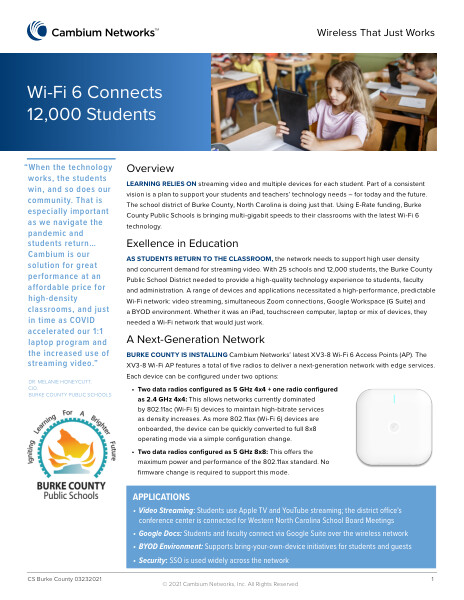Overview
Learning relies on streaming video and multiple devices for each student. Part of a consistent vision is a plan to support your students and teachers' technology needs – for today and the future. The school district of Burke County, North Carolina is doing just that. Using E-Rate funding, Burke County Public Schools is bringing multi-gigabit speeds to their classrooms with the latest Wi-Fi 6 technology.
Excellence in Education
As students return to the classroom, the network needs to support high user density and concurrent demand for streaming video. With 25 schools and 12,000 students, the Burke County Public School District needed to provide a high-quality technology experience to students, faculty and administration. A range of devices and applications necessitated a high-performance, predictable Wi-Fi network: video streaming, simultaneous Zoom connections, Google Workspace (G Suite) and a BYOD environment. Whether it was an iPad, touchscreen computer, laptop or mix of devices, they needed a Wi-Fi network that would just work.
A Next-Generation Network
Burke county is installing Cambium Networks’ latest XV3-8 Wi-Fi 6 Access Points (AP). The XV3-8 Wi-Fi AP features a total of five radios to deliver a next-generation network with edge services. Each device can be configured under two options:
- Two data radios configured as 5 GHz 4×4 + one radio configured as 2.4 GHz 4×4: This allows networks currently dominated by 802.11ac (Wi-Fi 5) devices to maintain high-bitrate services as density increases. As more 802.11ax (Wi-Fi 6) devices are onboarded, the device can be quickly converted to full 8×8 operating mode via a simple configuration change.
- Two data radios configured as 5 GHz 8×8: This offers the maximum power and performance of the 802.11ax standard. No firmware change is required to support this mode.
Centralized management is key. The district is using XMS-Cloud Network Management, an end-to-end solution, to deploy and manage their Wi-Fi network with complete control and visibility. XMS-Cloud permits network administrators to control up to 2,000 applications at the network’s edge where they can be allowed, blocked or throttled to achieve predictable performance, even under heavy network load.
Both the XV3-8 Wi-Fi 6 APs and XMS-Cloud management software seamlessly integrate with Google Workspace and other embedded education systems. Since its beginning in late 2020, the project is deploying 1,500 multi-gigabit high-density access points to the district’s schools.
Wi-Fi That Just Works
WHILE WI-FI 6 IS CHANGING THE PERFORMANCE of the wireless system in the district, it doesn’t change how learning is done. Wi-Fi 6 is simply providing multigigabit speeds that allow students to connect quicker than some of the older devices. One of the largest benefits for Burke County so far has been reliable, concurrent video streams in classrooms. Additionally, the network allows for a release when students move to another classroom, placing less strain on the Wi-Fi APs. With technology that performs consistently and invisibly to support learning, everyone wins.
Applications
- Video Streaming: Students use Apple TV and YouTube streaming; the district office’s conference center is connected for Western North Carolina School Board Meetings
- Google Docs: Students and faculty connect via Google Suite over the wireless network
- BYOD Environment: Supports bring-your-own-device initiatives for students and guests Security: SSO is used widely across the network
Success Factors
- Teamwork and Trust: Both technical and instructional education professionals need to work as a team. Those in leadership positions need to build relationships that create collaboration and trust your team to develop and implement a solution.
- Listen: Pay attention to teachers if they say there’s an issue. Listen to engineers and instructional tech facilitators; see if they’re pleased with the infrastructure and wireless. If not, be prepared to provide your team with more.
